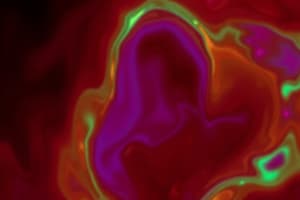Podcast
Questions and Answers
What is the primary method for deriving a surface image in the water-based segmentation approach?
What is the primary method for deriving a surface image in the water-based segmentation approach?
- Applying a Gaussian blur to smooth out noise
- Utilizing a histogram to enhance contrast
- Calculating the variance for each pixel within a 3x3 moving window (correct)
- Using a convolution filter on the original image
Which approach relies on the homogeneity of spatially localized features for image segmentation?
Which approach relies on the homogeneity of spatially localized features for image segmentation?
- Connectivity-preserving relaxation-based method
- Edge-based methods
- Water-based segmentation
- Region-grow approach (correct)
What is the main drawback of edge-based methods in image segmentation?
What is the main drawback of edge-based methods in image segmentation?
- They require grayscale images for processing
- They can only segment images in black and white
- They are computationally expensive and time-consuming
- They struggle with connecting broken contour lines (correct)
What mathematical concept is utilized in the connectivity-preserving relaxation-based method?
What mathematical concept is utilized in the connectivity-preserving relaxation-based method?
In the clustering process, what does the keyword represent?
In the clustering process, what does the keyword represent?
What is the role of merging segments in the water-based segmentation approach?
What is the role of merging segments in the water-based segmentation approach?
The region-grow approach is based on which assumption regarding neighboring pixels?
The region-grow approach is based on which assumption regarding neighboring pixels?
The active contour model in image segmentation utilizes which method to modify the initial boundary shape?
The active contour model in image segmentation utilizes which method to modify the initial boundary shape?
What is the main goal of image noise reduction?
What is the main goal of image noise reduction?
Which method is often used for measuring and classifying objects in an image?
Which method is often used for measuring and classifying objects in an image?
What does contrast enhancement primarily aim to improve in an image?
What does contrast enhancement primarily aim to improve in an image?
Which of the following describes lossy compression?
Which of the following describes lossy compression?
What is the purpose of window width (WW) in image processing?
What is the purpose of window width (WW) in image processing?
Which technique is primarily used for generating an image that is more visually appealing?
Which technique is primarily used for generating an image that is more visually appealing?
How does the 'window level' (WL) affect an image?
How does the 'window level' (WL) affect an image?
What is the main advantage of lossless compression?
What is the main advantage of lossless compression?
What is a primary effect of filtering on images?
What is a primary effect of filtering on images?
What do edges in an image indicate?
What do edges in an image indicate?
What limitation do edge detection algorithms have in medical imaging?
What limitation do edge detection algorithms have in medical imaging?
What is a potential drawback of enhancement methods in image processing?
What is a potential drawback of enhancement methods in image processing?
Which operation is necessary for spatial filtering?
Which operation is necessary for spatial filtering?
How can enhancement methods impact image details?
How can enhancement methods impact image details?
Why are edge detection algorithms considered just a tool in medical imaging?
Why are edge detection algorithms considered just a tool in medical imaging?
What does filtering primarily aim to modify in an image?
What does filtering primarily aim to modify in an image?
Flashcards are hidden until you start studying
Study Notes
Image Post-Processing
- Image Restoration: Improves image quality by correcting distortions and degradations
- Image Analysis: Enables measurements, segmentation, feature extraction, and object classification
- Image Synthesis: Creates images from other images or non-image data
- Image Enhancement: Generates visually appealing images
- Techniques include contrast enhancement, edge enhancement, spatial/frequency filtering, and noise reduction
- Image Compression: Reduces image size for faster transmission and storage
- Lossy compression: Sacrifices image detail for high compression ratios (up to 100:1)
- Lossless compression: Preserves all image information with lower compression ratios (around 5:1)
Windowing and Level
- Window width (WW): Determines the range of numbers displayed in an image
- Window level (WL): Represents the center point of the displayed range of numbers
- Window and level controls directly affect brightness and contrast
- Window controls brightness
- Level controls contrast
Filtering
- Purpose: Suppress unwanted information and enhance desired information
- Enhancive: Employed for edge enhancement, region enhancement, intensity scale standardization, and correction of background variation
- Suppressive: Primarily used for suppressing random noise
Edges
- Edge detection is essential for identifying structures within images by finding discontinuities in image intensity
- Edge detection algorithms are useful, but they sometimes identify irrelevant edges
- Manual intervention may be required for accurate structure identification
Image Segmentation Approaches
-
Water-Based Segmentation: Utilizes watersheds to delineate regions based on spectral similarity
- Steps:
- Derive surface image: Variance images are calculated, and a weighted average is used to create a surface image for delineation
- Delineate watersheds: Pixels with homogeneous features form watersheds
- Merge segments: Adjacent watersheds with similar spectra can be merged to form larger segments
- Steps:
-
Region-Grow Approach: Leverages pixel homogeneity to group regions
- Based on the assumption that neighboring pixels within the same region share similar intensity values
-
Edge-Based Methods: Rely on contour detection, but are susceptible to errors when contours are broken or blurred
-
Connectivity-Preserving Relaxation-Based Method: Employs an active contour model to iteratively modify an initial boundary shape
- The model uses shrink/expansion operations based on an energy function to refine the boundary
- Partial Differential Equations (PDEs) are commonly used for medical image segmentation in this approach
Studying That Suits You
Use AI to generate personalized quizzes and flashcards to suit your learning preferences.




